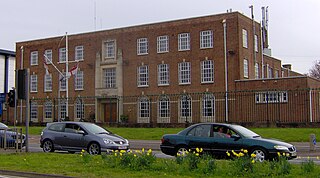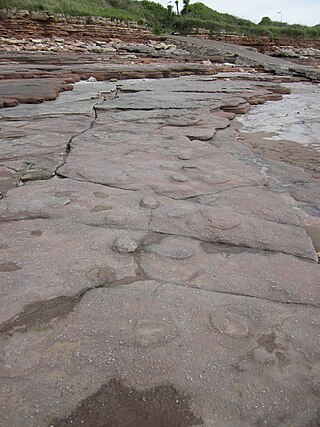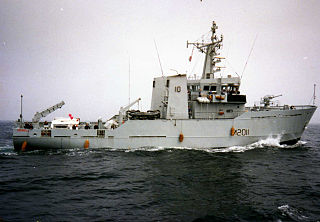 | |
| History | |
|---|---|
| Name | HMS Cambria |
| Commissioned | July 1947 |
| Status | Extant |
| Badge |  |
| General characteristics | |
| Class and type | Stone frigate |
HMS Cambria is the lead Royal Naval Reserve unit in Wales. It is based in the docks of the Welsh capital, Cardiff.
 | |
| History | |
|---|---|
| Name | HMS Cambria |
| Commissioned | July 1947 |
| Status | Extant |
| Badge |  |
| General characteristics | |
| Class and type | Stone frigate |
HMS Cambria is the lead Royal Naval Reserve unit in Wales. It is based in the docks of the Welsh capital, Cardiff.
HMS Cambria was established as the Royal Naval Reserve unit for South Wales in July 1947 and originally occupied buildings in Cardiff Docks. Cambria remained in Cardiff until 1980, when the redevelopment of the docks there precipitated a move to the former service married couples' accommodation at Sully, Vale of Glamorgan, and was granted freedom of that county in 2012. Cambria returned to a purpose built home in Cardiff Docks in 2020.
Over the years Cambria, like many other RNR units, operated a number of seagoing ships; a motor minesweeper – the unit's first tender – was replaced in 1954 by the wooden-hulled minesweeper Brereton, which gave way in turn to Crichton (1961–76); all of these were rechristened HMS St David. In 1978 the unit acquired a converted trawler, which was again renamed St David. The ship's final vessel, acquired in 1984, was the new minesweeper Waveney, which was not renamed. Waveney remained with HMS Cambria until 1994, when a reorganisation of the RNR led to the abandonment of seagoing tenders. [1]
Cambria is one of only three RNR units to have a satellite unit. The Swansea-Tawe Division, based at Swansea, began its life as a Royal Naval Volunteer Reserve Wireless unit in 1932. Having originally begun life with just one recruit, the unit had expanded to 48 members by 1970. The unit was briefly commissioned as the stone frigate HMS Dragon from 1984 to 1994, but was subsequently made subordinate to Cambria and rechristened to its current name.

The Royal Naval Reserve (RNR) is one of the two volunteer reserve forces of the Royal Navy in the United Kingdom. Together with the Royal Marines Reserve, they form the Maritime Reserve. The present RNR was formed by merging the original Royal Naval Reserve, created in 1859, and the Royal Naval Volunteer Reserve (RNVR), created in 1903. The Royal Naval Reserve has seen action in World War I, World War II, the Iraq War, and War in Afghanistan.
Five ships and a shore establishment of the Royal Navy have been named HMS Mersey after the River Mersey:

The Ton class were coastal minesweepers built in the 1950s for the Royal Navy, but also used by other navies such as the South African Navy and the Royal Australian Navy. They were intended to meet the threat of seabed mines laid in shallow coastal waters, rivers, ports and harbours, a task for which the existing ocean-going minesweepers of the Algerine-class were not suited.

The Royal Naval Auxiliary Service (RNXS) was a uniformed, unarmed, civilian volunteer service, administered and trained by the Royal Navy to operate in the ports and anchorages of the United Kingdom in an emergency. Although the abbreviated title would logically have been RNAS this abbreviation had long been taken by the various Royal Naval Air Stations, so RNXS it was. It maintained training units, and vessels at most major ports in the UK. and was formed in 1963 from the amalgamation of the Royal Naval Mine-watching Service (RNMWS) and Admiralty Ferry Crew Association in response to the perceived nuclear threat to British ports. The service was disbanded on 31 March 1994 due to Ministry of Defence (MOD) cuts. Most vessels from its fleet were transferred to the Royal Navy or sold, with the exception of XSV Loyal Volunteer, which was struck by a ro-ro ferry while berthed in Ipswich Harbour and was later scrapped.
HMS Kirkliston (M1157) was a Ton-class minesweeper of the Royal Navy, built by Harland and Wolff and launched on 18 February 1954. In a brief episode from 1956 to 1960 she was temporarily renamed HMS Kilmorey and was assigned to the Ulster division Royal Naval Reserve (RNR).

HMS Flying Fox is a Royal Naval Reserve unit located in Bristol, England. Training over 100 reservists on Thursday evenings in Bristol, Flying Fox serves Bristol, Dorset, Devon, Somerset, Wiltshire and Gloucestershire.
Seven ships of the Royal Navy have been named HMS Venturer, with an eighth announced:

The Bendricks is a stretch of coastline and an important paleontological site in the Vale of Glamorgan in south Wales located along the northern coast of the Bristol Channel between Barry and Sully at 51°23′46″N3°14′50″W. It lies at the foreshore of the industrial port of Barry between the eastern breakwater of the Barry docks entrance on its western edge to Hayes Point on its eastern edge. This area of the coast is a Site of Special Scientific Interest.

HMS Eaglet is a Royal Navy Reserve unit based in Liverpool. She is the main occupant of the Royal Navy Regional Headquarters in Liverpool, Merseyside. The base is also the home to a number of units, including:Royal Marines Reserve Merseyside, Naval Regional Command Northern England, Liverpool URNU, HMS Biter, HMS Charger, Sea Cadet Corps, and the Liverpool Royal Navy and Royal Marines Careers Office.

Sir Norman Lloyd-Edwards served as the Lord Lieutenant of South Glamorgan from 1990 to 2008.

HMS President is a "stone frigate", or shore establishment of the Royal Naval Reserve, based on the northern bank of the River Thames near Tower Bridge in Wapping and is in the London Borough of Tower Hamlets.

HMS Fittleton, originally named HMS Curzon, was a wooden-hulled Ton-class minesweeper of the Royal Navy which spent most of her career in the Royal Naval Reserve. She was sunk in a collision with HMS Mermaid on 20 September 1976 whilst en route to Hamburg for an official visit. Twelve naval service personnel lost their lives, making this the worst peacetime accident involving the Royal Naval Reserve.
Three ships of the Royal Navy have borne the name HMS St David, after Saint David, patron saint of Wales:
HMS Hodgeston was a Ton-class minesweeper which saw service with the Royal Navy during the Cold War. Built by Fleetlands Shipyard, she was launched on 6 April 1954 and broken up in 1988.
HMS Cambria is the lead Royal Naval Reserve unit in Wales. HMS Cambria's present headquarters is located on Cargo Road in Cardiff Bay.
HMS Dalriada is Glasgow's Royal Naval Reserve unit. It is based in Govan, one of the city's south-western suburbs.

BNS Shapla is a River class minesweeper of the Bangladeshi Navy. Formerly the Royal Navy fleet minesweeper HMS Waveney (M2003). She is serving Bangladeshi Navy from 1995.
In 1989 the Royal Navy was under the direction of the Navy Department in the UK Ministry of Defence. It had two main commands, CINCFLEET and Naval Home Command.

HMS Sherwood is a Royal Naval Reserve shore establishment in Nottinghamshire, England. The first naval reserve unit was established in Nottingham in 1949. It was commissioned as Sherwood in 1984, at which time the unit was based at Chalfont Drive, Beechdale. A Royal Marines Reserve detachment was added to the unit in 2007. In 2014 HMS Sherwood moved to Chetwynd Barracks, Chilwell, where it was co-located with an Army Reserve unit. Sherwood was honoured by receiving the freedom of the city of Nottingham in 2018.

The Armed forces in Wales are the military bases and organisation in Wales or associated with Wales. This includes servicemen and women from Wales and Welsh regiments and brigades of the British Armed Forces.